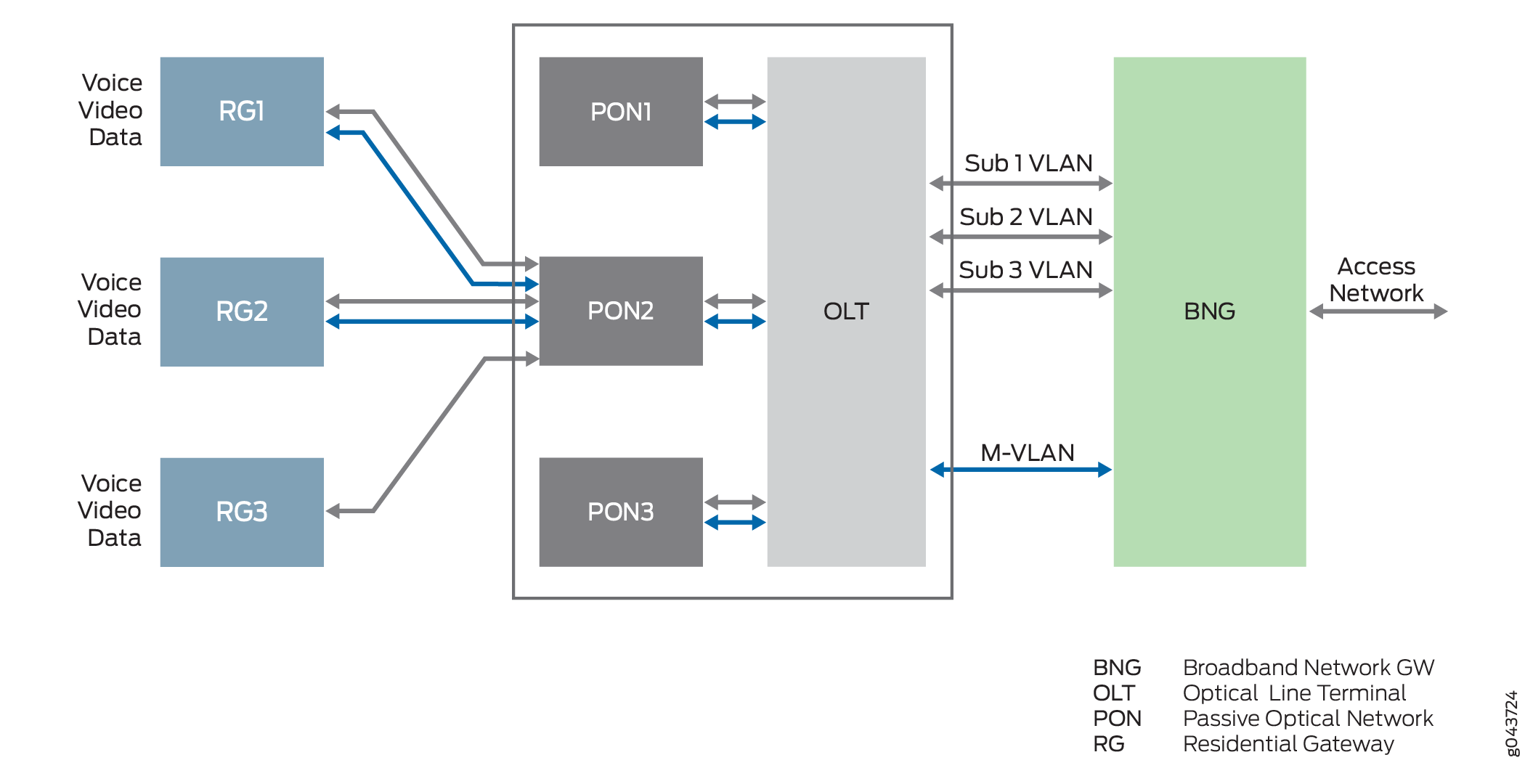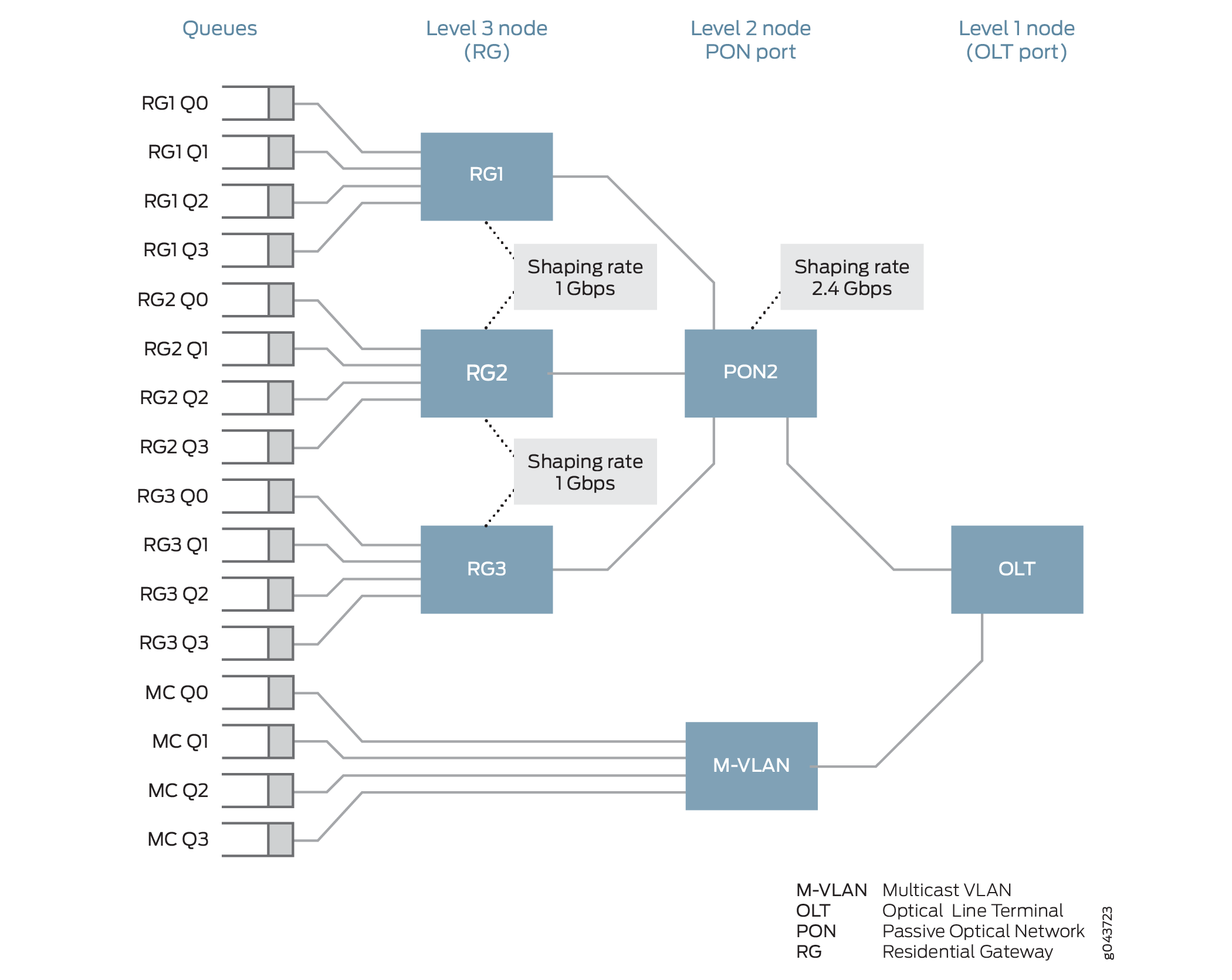Using Hierarchical CoS to Adjust Shaping Rates Based on Multicast Traffic
For service providers that are using interface sets to deliver services such as voice and data and multicast VLANs (M-VLANs) to deliver broadcast television, you can set up CoS so that when a subscriber begins receiving multicast traffic, the shaping rate of the subscriber interface is adjusted to account for the multicast traffic. You can also set up the class of service (CoS) multicast adjustment to be propagated from the subscriber interface to the interface set, which is the parent in the scheduler hierarchy. This feature prevents oversubscription of the multicast replicator, such as a PON, which can result in dropped traffic and service disruption.
For broadcast television, instead of transporting separate video streams from the source to each subscriber receiving the same stream, the broadband network gateway (BNG) uses M-VLANs to send one stream to the access node. The access node, such as an Optical Line Terminal (OLT) or a DSLAM, replicates the video stream for each subscriber that is currently watching a particular television channel. In this scenario, M-VLANs are used to stream television and interface sets are used to manage traffic to the access node. An interface set contains an interface for each subscriber that is attached to the access node. See Figure 1 for a typical broadcast television network topology.

When a subscriber begins watching a television channel, the BNG detects that the subscriber has joined a multicast group and has begun receiving traffic from an M-VLAN. The BNG adjusts traffic shaping on the subscriber interface to account for the bandwidth that the multicast traffic is using. For example, if a subscriber begins watching a television channel, the BNG reduces the bandwidth on the subscriber interface to account for the bandwidth being used by the multicast traffic. If you set up CoS to propagate the reduced bandwidth of the subscriber interface to the interface set, the interface set’s shaping rate is also reduced.
The BNG uses CoS adjustments based on three-level hierarchical CoS scheduling to implement this feature. Level 2 in the scheduler hierarchy is the interface set, and level 3 is the logical interface. To use this feature, you configure traffic-control profiles for logical interfaces (level 3) to adjust the parent interface set (level 2).
You can set up CoS adjustments to the parent interface set to
happen once for each broadcast television channel being streamed over
the M-VLAN by including the
qos-adjust-hierarchical interface-set at the [edit dynamic-profiles dynamic-profile-name access-cac interface $junos-interface-name] hierarchy. For example:
user@host# set dynamic-profiles dynamic-profile-name access-cac interface $junos-interface-name qos-adjust-hierarchical interface-set
To illustrate the benefit of this feature, consider two scenarios from Figure 2, which shows a possible subscriber scheduler hierarchy with M-VLANs.

Scenario 1
Each of 32 subscribers on PON2 are consuming as much data as they can. Each subscriber receives (2.4 Gbps / 32 subscribers) = 75Mbps. Subscriber 1 on PON2 starts watching a 120Mbps multicast video stream. Each subscriber receives (2.4Gbps – 120Mbps) / 32 subscribers = 71.25Mbps of data. Subscriber 1 receives 120Mbps of video, and 71.25Mbps of data. Then Subscriber 2 on PON2 starts watching a different 120Mbps multicast video stream. Each subscriber then receives (2.4Gbps – 240Mbps) / 32 subscribers = 67.5 Mbps of data. Subscribers 1 and 2 receive 120Mbps of video and 67.5Mbps of data.
Final QoS adjustments:
-
Subscriber 1’s shaping-rate is reduced by 120Mbps to 880Mbps.
-
Subscriber 2’s shaping-rate is reduced by 120Mbps to 880Mbps.
-
PON2’s shaping-rate is reduced by 240Mbps to 2.160Gbps, leaving all 32 subscribers to equally share 2.160Gbps – which is 67.5Mbps each.
Scenario 2
Each of 32 subscribers are consuming as much data as they can. Each subscriber receives (2.4 Gbps / 32 subscribers) = 75Mbps. Subscriber 1 on PON2 starts watching a 120Mbps multicast video stream. Each subscriber then receives (2.4Gbps – 120Mbps) / 32 subscribers = 71.25Mbps of data. Subscriber 1 gets 120Mbps of video, and 71.25Mbps of data. Subscriber 2 on PON2 then starts watching the same 120Mbps multicast video stream. This is completely serviced. Since this is the same video stream as Subscriber 1 is watching, and the stream is being replicated at the PON, only one subscriber adjustment is needed. No additional PON adjustment is needed due to subscriber 2 watching the same 120Mbps multicast video steam.
Final QoS adjustments:
-
Subscriber 1’s shaping-rate is reduced by 120Mbps to 880Mbps.
-
Subscriber 2’s shaping-rate is reduced by 120Mbps to 880Mbps.
-
PON2’s shaping-rate is reduced by 240Mbps to 2.280Gbps, leaving all 32 subscribers to equally share 2.280Gbps – which is 71.25Mbps each.
When any one of the two subscribers receiving the 120Mbps video stream unsubscribes, the adjustment for that subscriber is reverted. The other subscriber’s adjustment remains, as does the PON’s adjustment. When the remaining subscriber unsubscribes the adjustment for that subscriber is reverted, as is the PON’s adjustment.
